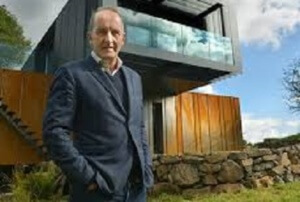 A new study in the journal Design and Culture explores how the programme Grand Designs presents architecture and domestic design to a non-specialist audience.
A new study in the journal Design and Culture explores how the programme Grand Designs presents architecture and domestic design to a non-specialist audience.
Peter Lloyd (University of Brighton) and Arlene Oak (University of Alberta) focus their study on two episodes of the programme, both of which feature homes made from straw bales. In their view, how Grand Designs and its presenter Kevin McCloud deal with sustainability, notions of expertise and the design process itself are what makes it a unique offering in a crowded television ‘property’ market.
Lloyd and Oak draw particular attention to the fact that Grand Designs both reflects and promotes the current desire for homes that are more ‘sustainable’ or ‘environmental’. They write: “Forms of eco-consciousness engage with other considerations that relate to the build (e.g. financial, structural, or aesthetic issues). Instead of a simplistic rendition of sustainability, the show depicts the intersection between environmentalist, (design) professional, and pragmatic concepts of eco-awareness. This means that Grand Designs offers the opportunity to explore how sustainability may actually be enacted in practice as a form of ‘ethical consumption’.”
In the case of the two straw-bale projects Lloyd and Oak study, the programme’s narratives are structured to present different views on sustainability. In the world of Grand Designs, sustainability can come from adopting new technologies, or, more commonly, from returning to the traditions of the past.
“Television offers the possibility of taking a critical look at the intersection between talk and design, without being beholden to the interests of specific practitioners,” they observe.
Much of Grand Designs’ success is due to the character and expertise of presenter Kevin McCloud. “He has significant power to influence the audience with his own ideas about what constitutes sustainability or eco-awareness, and to further frame himself within wider culture as an ‘expert’ and authoritative voice in issues pertaining to sustainability, design, and domestic architecture,” they observe.
The authors state “We hope our paper encourages more researchers to use television and other media as data in looking critically at processes of design”.
As a television series introducing the public to design, McCloud ‘frames design practice as an essentially heroic and artistic activity, undertaken, as it is in these episodes, by uncompromising individuals’ – but this approach is not without its problems. As Lloyd and Oak note, framing people who take on such projects as ‘romantic idealists’ willing to put everything on the line, may be ‘out of kilter with more collaborative approaches to [current] creative practice’ – but it’s made for 15 years of engaging and informative viewing.
Reference: Houses of Straw: Grand Designs and the Presentation of Architectural Design on Television, Peter Lloyd & Arlene Oak published by Taylor & Francis.
Read the full article online: http://www.tandfonline.com/ doi/full/10.1080/17547075. 2016.1187909

